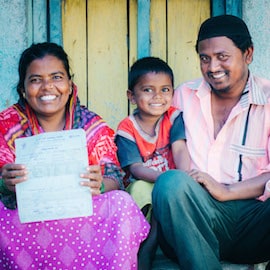How Foreign Aid Can Innovate Itself Out of Existence: Exploring the Potential of Market-Creating Innovation for Sustainable Development
Waste, inefficiency, short-term thinking and a lack of focus were some of the problems identified in a New York Times article about the future of foreign aid. That may seem unremarkable — it’s a common enough critique.
But the article was written in 1962. Sadly, 60 years on, many of those same issues still plague the sector today.
Economists have observed that foreign aid does not appear to have generated economic growth in developing countries all around the world. Though the modest size of global aid budgets may be a factor in this lack of impact, spending more is unlikely to solve the problem, as only about a third of aid even makes it to governments and organizations in recipient countries. And in many cases, developed countries give aid to support their strategic allies, commercial interests, and moral or political beliefs, rather than the interests of the local people. That can lead to inefficient spending on ineffective projects — and when the donor country’s strategic interests change and the aid dries up, recipient countries often find themselves back where they started.
In light of these shortcomings, it’s not surprising that, despite noteworthy global progress, most of the countries that were poor 60 years ago still have high rates of poverty today. And those countries that have largely driven the declines in global poverty — China and India — owe their progress primarily to internal economic reforms and growing international trade, not foreign aid. Indeed, the ingenuity of innovators and the stream of investments to support entrepreneurs, both local and global, have been the main determinants of long-term development progress in emerging economies.
However, foreign aid’s inability to generate consistent economic growth and poverty alleviation is not due to a lack of effort. It is due to a lack of innovation.
To sustainably support development, foreign aid must evolve to support high-impact, market-creating innovations that advance local prosperity. Market-creating innovations transform complicated and expensive products into simple and affordable ones, making them accessible to many more people in society. These innovations are unique in their ability to trigger economic prosperity at scale.
The Power of Market-Creating Innovation
For example, at a time when the United States had similar demographics to many of the world’s poorest countries today, innovators across the country created new markets that made products accessible to a whole new population of Americans. Isaac Singer built a multinational company that made sewing machines accessible; Henry Ford did the same with the car; and believe it or not, Bank of America got its start as Bank of Italy, targeting hard-working immigrants that were left out of the banking system.
As these American innovators created new markets that served millions more people, the markets generated many other things that benefited society, including jobs, taxes, regulations — and perhaps most importantly, a belief that a nation can prosper through innovation. These people and the businesses and markets they created changed the culture of America.
A similar process took hold in Japan after World War II, as market-creating innovations took center stage in the war-torn country’s recovery. Though it’s now one of the richest countries in the world, in 1950, Japan was poorer than Mexico and Colombia. Its prospects for development were poor, and prosperity seemed unlikely. But Japan developed, and continues to prosper, primarily through investments in market-creating innovations.
For example, Sony’s humble beginnings in a bombed-out factory did not stop its founders Akio Morita and Masaru Ibuka from making consumer electronics simple and affordable for many Japanese people. From the transistor radio to the Walkman, Sony developed more than a dozen market-creating innovations from 1950 through the 1980s. Sony wasn’t alone, however. Toyota, Honda, Mitsubishi, Suzuki, and many of the Japanese companies we revere today also created new markets that served Japanese people left out of the existing market. These markets had a similar impact on Japan as they did on America. They created jobs, generated taxes and instilled a culture of innovation across Japan.
A similar phenomenon — investing in and reaping the rewards of market-creating innovations — is possible even in the world’s poorest regions.
Across Africa, the average person now has access to a mobile phone. This sector has supported more than 3 million jobs, generates billions of dollars in taxes, and is worth almost $140 billion in economic value. Meanwhile, in India, Narayana Health, Aravind and other healthcare organizations are making it possible for average Indians to consume formerly expensive and inaccessible healthcare services. And in Brazil, innovators such as Nubank and MindLab are transforming financial services and education respectively.
In light of the proven, long-term impact these businesses can generate, what if foreign aid focused on cultivating a culture of market-creating innovation globally?
How foreign aid can support market-creating innovation
Investing in market-creating innovation is complex — but critical. Governments in high-income countries across the world fund locally-led innovations to create jobs and advance critical services. But while the foreign aid industry is well-versed in investing in poverty alleviation, it has not evolved to invest systematically in supporting the efforts of governments, local private sectors and institutions to build systems that can help generate both social impact and sustained prosperity.
However, a number of programs are emerging that are anchoring their investments and activities on innovation and the creation of new markets in underserved areas. Over the past several months, I’ve had the opportunity of serving on the steering committee of a new program with much promise. The Investing in Innovation (i3) program is a cutting-edge, pan-African initiative that aims to kickstart a new way of mobilizing aid, business and African institutions in order to support local innovation.
The initiative began its inaugural year in 2022, by supporting the efforts of 30 promising early- and growth-stage entrepreneurs working in healthcare supply chains (including companies like LifeBank, Vaxiglobal, Zuri Health and Meditect) to deliver affordable, high-quality health products to underserved populations. In its second year, i3 will support another 30 promising early- and growth-stage startups in the healthcare sector. The program is funded by the Bill & Melinda Gates Foundation and sponsored by Merck Sharp & Dohme, the World Health Organization Regional Office for Africa, AUDA-NEPAD, and AmerisourceBergen. It offers selected innovators access to markets, risk-tolerant financing and investment-readiness support.
Over time, i3 will build a robust ecosystem of partners and innovators that will help ensure Africa’s healthcare infrastructure is strong. As a result, if it succeeds, the program will not get bigger, but smaller — and ultimately, it will end. But its end will simply signify the emergence of a strong and vibrant healthcare ecosystem for Africa.
This model provides a strong contrast to the typical, open-ended approach taken in foreign aid, which is based on the unspoken assumption that the aid will still be needed in the future — i.e., that it will ultimately fail to generate self-sustaining economic growth. Instead of continuing to support a myriad of programs that add value but don’t fundamentally put a country on the path toward prosperity, more foreign aid programs should model themselves after the i3 initiative. If they do, it will mean the beginning of the end is near for these programs — and that’s okay. The goal of foreign aid was never — and should never be — to aid forever. The end of foreign aid will signal the beginning of prosperity for all.
Efosa Ojomo leads the Global Prosperity research group at the Clayton Christensen Institute for Disruptive Innovation.
Photo: Henry Ford drives the 20 millionth Model A off the assembly line. Photo credit: Txemari. (Navarra)
- Categories
- Health Care, Investing



